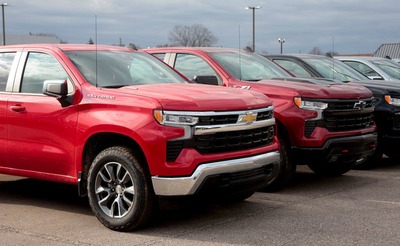US car buyers face higher prices, less choice under Trump's tariffs

*
Automakers may stop selling affordable models, impacting U.S. consumers
*
Tariffs could add
*
Automakers face tough decisions on production and supply chains
By
"Most car makers can't eat 25%, they just can't," said
Automakers may spread that cost between U.S.-produced and imported models, cut back on features, and in some cases, stop selling affordable models aimed at first-time car buyers, as many of those are imported and less attractive if they carry a higher price tag.
The changes could price more Americans out of the market.
S&P Global Mobility estimated Thursday that tariffs will cause
annual U.S. vehicle sales to fall to a range of 14.5 million to
15 million in coming years from 16 million in 2024.
"Car makers know they have certain vehicles in their portfolio that can tolerate lower profit margins," Keating said. "Some vehicles may just prove to be too expensive, and most of those are affordable models manufactured outside the U.S."
After 10% of the car-buying population was priced out of the market during the coronavirus pandemic, affordability still remains high on consumers' minds, Keating said.
"Would tariffs bite into another 10% of people who would be priced out?" she said. "Potentially."
U.S. auto dealers currently have plenty of inventory - about
90 days worth - but prices could start to rise after that. In
recent weeks,
'EVERYONE HURTS'
European and Asian car makers, deprived of the largest auto importing market, could cut production. If automakers stop shipping a model to the U.S., that would translate into lower production at those factories. Lower volumes mean higher costs per vehicle, "which ultimately will be passed on to consumers" in those markets, Palmer said.
On Thursday
"What I'm hearing within the next couple of weeks (is)
prices are probably gonna jump, and they're already high," Reed
said.
Some companies selling U.S.-made cars with a high percentage of
tariff-exempt parts could raise prices to boost profits but
still keep them low enough to take market share from
tariff-affected rivals. Longer-term, major automakers would have
to decide whether to ride out tariffs on a bet that they won't
last, or spend two to three years moving production and supply
chains under the expectations that tariffs would last beyond
Trump's presidency, said
"Those ones could be big winners in three or four years if
the tariffs really stay in," Wakefield said. "Or they could be
losers if it somehow unwinds and they're stuck with higher
costs."
Newer automakers like
"I don't think it's possible to pass a price increase in the range of 25% onto a consumer," she said. "But equally, it's also very clear that we can't absorb it all."
She said INEOS will split the burden between the company, its dealers and consumers, a hybrid solution where "everyone hurts."
(Reporting By
(c) Reuters 2025. All rights reserved. Republication or redistribution of Reuters content, including by caching, framing or similar means, is expressly prohibited without the prior written consent of Reuters. Reuters and the Reuters sphere logo are registered trademarks and trademarks of the Reuters group of companies around the world.
Related News
-
Newsmax Shares Rally in NYSE Debut; Trading Halted on Volatility
MT Newswires - 23 minutes ago
-
Update: CGI to Buy Apside, Launches CGI Advantage With Ventura County
MT Newswires - 25 minutes ago
-
Benzinga - 25 minutes ago
-
Volt Lithium Receives US$2 Million Grant From North Dakota Govt
MT Newswires - 35 minutes ago
-
Bank of Nova Scotia Has 'Narrow Path' to Outperform in Uncertain Macroeconomic Landscape, BofA Says
MT Newswires - 38 minutes ago
-
Update: Vizsla Silver Reports New High-Grade Discovery at Panuco Project in Mexico
MT Newswires - 40 minutes ago
-
Boeing's Starliner 'Most Robust,' Says Astronaut Post-Delayed Return
MT Newswires - 42 minutes ago






